May 5, 2006
Air Date: May 5, 2006
FULL SHOW
SEGMENTS
Venus or Bust
View the page for this story
Two NASA satellites and the European Space Agency’s Venus Express have set out to find clues that will aid scientists’ understanding of climate change on Earth. Astrophysicist Neil deGrasse Tyson tells Living on Earth host Steve Curwood about these missions and about why Venus is hot and Earth is not frozen. (07:20)
Star Search
/ Jean KumagaiView the page for this story
As scientists around the world rush to find out more about our universe, Living on Earth takes a look at one new telescope in South America. Spectrum Radio’s Jean Kumagai reports on the new Apex Telescope located in the Chilean Andes. (04:40)
Carbon Confessionals
View the page for this story
Ford has teamed up with an eco-investment group to provide car buyers with a way to offset their CO2 emissions. When people purchase a Terrapass their money is pooled with more than 10,000 other customers and invested in renewable energy sources like wind and methane. Host Steve Curwood speaks with Terrapass's inventor Karl Ulrich of the Wharton School. (07:15)
Listener Letters
View the page for this story
We hear from our listeners. (02:30)
Liberating Liberia
/ Steve CurwoodView the page for this story
When Silas Siakor became aware of the government corruption behind logging in his homeland, he decided to take action, even if it would mean risking his life. For his courage, Siakor was awarded the prestigious Goldman Environmental Prize. Host Steve Curwood caught up with him after the ceremony to hear his story. (06:50)
Emerging Science Note/Seasonal Maladies
/ Bobby BascombView the page for this story
New research links being born in certain seasons with elevated suicide rates. Bobby Bascomb reports. (01:30)
The Man Cave
View the page for this story
The workshop, the tool shed, the hunting lodge and the Lazy Boy have one thing in common. Author James Twitchell says they are all places where men go to get away. Host Steve Curwood talks with Twitchell about his new book, packed with photographs, "Where Men Hide." (06:00)
The Eco-Lap of Luxury
/ Steve CurwoodView the page for this story
This funky yet luxurious San Francisco hotel offers tip-top environmentally friendly accommodations. Host Steve Curwood takes a tour. (08:00)
What Calls Beneath
/ Jeff RiceView the page for this story
The Columbia Spotted Frog has an unusual way of communicating. Jeff Rice reports. (03:00)
This week's EarthEar selection
listen /
download
The calls of Arizona treefrogs, who are not afraid to make themselves known.
Show Credits and Funders
Show Transcript
HOST: Steve Curwood
GUESTS: Neil deGrasse Tyson, Karl Ulrich, Silas Ceaco
REPORTERS: Jean Kumagai, Jeff Rice
NOTE: Bobby Bascomb
[THEME MUSIC]
CURWOOD: From NPR, this is Living on Earth.
[THEME MUSIC]
CURWOOD: I’m Steve Curwood. By the time we find out exactly what the human impact is on the Earth’s climate it may be too late to change things. So scientists are sending probes to other planets for some answers, planets that also have hotter temperatures from the greenhouse effect.
TYSON: For Mars that increment is about five degrees above what it would otherwise be; Earth it’s about 35 degrees. In fact, without our greenhouse effect we’d be in a perpetual ice age. Venus is the runaway greenhouse effect where it’s 500 degrees excess temperature brought about from these gases.
CURWOOD: Interplanetary science and global warming, this week on Living on Earth. Also, using your wallet to lighten the climate impact of your car.
ULRICH: We do mitigate emissions, we just don't do it at the tailpipe of that vehicle.
CURWOOD: Stick around.
[NPR NEWSCAST]
ANNOUNCER: Support for Living on Earth comes from the National Science Foundation and Stonyfield Farm.
[THEME MUSIC]
Venus or Bust
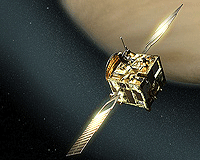
Venus Express will study the effects of the solar wind on the Venusian space environment. (ESA - AOES Medialab)
CURWOOD: From the Jennifer and Ted Stanley Studios in Somerville, Massachusetts, this is Living on Earth. I’m Steve Curwood.
At the end of April NASA launched two satellites into orbit designed to tell us how clouds affect global warming. This is not the only space mission intended to shed light on climate. The Venus Express, a European spacecraft, recently eased into orbit around Venus to study its atmosphere. The craft will circumnavigate the planet nearest to Earth for at least two Venusian days – that’s about 485 Earth days – and gather information to increase understanding about climate change on this planet.
With me now is Neil deGrasse Tyson. He’s an astrophysicist and heads New York’s Hayden Planetarium. Neil, welcome back to Living on Earth.

Venus Express will study the effects of the solar wind on the venusian space environment. (ESA - AOES Medialab)
CURWOOD: I detect that there’s increased interest among the international space agencies in climate change. What are they looking at particularly?
TYSON: The way to think about that is every next mission now knows that climate change is a big issue. And so as you design those spacecraft you’ll design them slightly differently to explore what drivers may be responsible for climate change. In the past, all you really cared about was perhaps tomorrow’s weather, or whether it would rain this afternoon. And so once you understand that there’s something bigger happening you get to change the scope and the vision statement of what it is that drives your satellite design and the questions that you aim to answer with the experiments on board. So, yes, I think we’re all kind of worried. And even people who didn’t used to be worried are worried.
CURWOOD: Now let’s look at NASA’s satellite mission. They’ve got one satellite that is going to be using lidar, which is like radar only it’s laser instead of radio waves, and infrared, to look at clouds. What’s important about clouds in terms of climate change?
TYSON: The atmosphere is one of the most complex systems you could possibly model scientifically. There are all of these drivers – there are heat sources, there are heat sinks, there’s movement of countless numbers of particles, there are aerosols, there’s human intervention with the weather. And when you combine all of this, what you really want is the best possible data you can attain.
And the way to do that is not simply to look up at the bottoms of clouds. You want to look at what they look like from the top, but also you want to probe what’s going on inside of them. So, it’s the three-dimensional structure of clouds that will add to the database of these atmospheric modelers so we can claim to understand what is going on right above our heads.
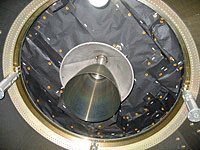
Close-up view of Venus Express main engine (ESA)
TYSON: Well, first of all, not all of space is NASA. People need to remember that. And there’s not enough attention, I think, given to the rest of the world’s efforts to understand Earth and the solar system. The European Space Agency is one among several. Japan has one. Of course, Russia has one as well. And China has a nascent one.
But these efforts – Europe said they wanted to figure out what’s going on on Venus. Venus is one of the most mysterious places in the solar system. It’s known as our sister planet. It’s about the same size as Earth but it’s completely different climatically. It’s nearly 900 degrees Fahrenheit, and it’s got a thick cloud cover which triggers a runaway greenhouse effect which is responsible for that high temperature.
And so, one of the most mysterious planets – simply because it’s cloaked from our view – needs this kind of attention which we should have given it a long time ago.
CURWOOD: What is in the thick clouds of Venus?
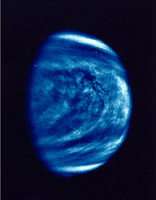
Clouds of Venus, taken from NASA’s Galileo (NASA)
From what we do know about Venus, its surface is interesting because it’s much, much smoother than should be the case given the history of meteor impacts on planet surfaces. And there’s been a long suspicion that the surface got completely repaved by some kind of episodic or catastrophic volcanic activity where lava just sort of spills out into the lowlands, creates these broad, flat smooth surfaces, hiding any cratering record. One of the things people are trying to understand is what’s going on in Venus’ atmosphere, what’s going on Venus’ surface.
CURWOOD: Neil, what are the planets that have greenhouse effects? That is, where the atmosphere lets the sunlight in and blocks radiation from escaping, like Earth and Venus?
TYSON: First, you have to recognize some of the most common greenhouse gases. The one we all know about is carbon dioxide, and that’s most of Venus’ and Mars’ atmosphere. But then there’s also water vapor, makes a good greenhouse gas, as well as methane. And so a look around the solar system for planets that have those in its atmosphere, and there will be energy trapped in that atmosphere, solar energy trapped, and thereby giving those places a slightly or excessively higher temperature than it otherwise would.
For Mars, that increment is about five degrees above what it would otherwise be. Earth, it’s about 35 degrees. In fact, without our greenhouse effect we’d be in a perpetual ice age. Venus is the runaway greenhouse effect where it’s 500 degrees excess temperature brought about from these gases.
CURWOOD: Neil, what decides a planet’s climate?
TYSON: That’s an excellent question because it’s completely different if a planet doesn’t have water when compared with if it does. So on Mars and Venus it’s the sun heating the surface creating the sort of vertical connective currents where basically the atmosphere boils. The lower part heats and hot air rises, as we all know, and goes up to the top and then cycles back down again. So this can create currents not only top-to-bottom but side-to-side, as you have a rotating planet.
On Earth we have not only land but ocean. And so that complicates things because the sun heats the ocean, the ocean puts water vapor into the atmosphere, and sideways air currents carry that water vapor over the land. You get too much of that, you get rainstorms. But, in the end, the sun is completely responsible for what’s going on with our climate. Without the sun we would just have this stagnant atmosphere and we would be frozen. So the sun does a lot of things for Earth, including accounting for our climate.
CURWOOD: Neil deGrasse Tyson heads the Hayden Planetarium in New York. He’s also the new host of PBS’s Nova ScienceNow that begins with this fall season. Neil, thanks for taking this time.
TYSON: It’s a pleasure to be back with you.
Related link:
European Space Agency
[MUSIC: Animal Collective “Did You See The Words” from ‘Feels’ (Fat Cat/Caroline - 2005)]
Star Search
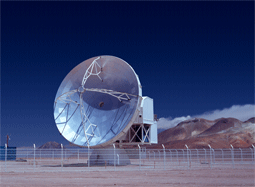
The APEX Telescope at Chajnantor (European Southern Observatory)
CURWOOD: To get a clearer view of the universe, astronomers are pushing the limits of technology – lofting new telescopes into space, burying them deep underground in abandoned mines, and placing them atop some of the world’s highest and most remote mountains. Jean Kumagai recently traveled to the Andes of Chile to see one these extreme telescopes and she has this report.
[DRIVING NOISES]
KUMAGAI: To reach one of the highest telescopes in the world you have to travel up, of course. Up along a rutted dirt road that winds its way to the peak of Cerro Chajnantor, nearly 17 thousand feet above sea level. The higher we climb in our dust-covered pickup, the more the wind howls, and the colder it gets. Soon, tall snowdrifts, the remnants of a recent blizzard, surround us.
[DRIVING SOUNDS]
KUMAGAI: Our destination is the new Atacama Pathfinder Experiment, or APEX, the largest radio telescope in the southern hemisphere. It sits on a rocky plateau near the summit…a giant, shining white dish that looks improbably high-tech against the austere mountain landscape. Kind of like finding a bullet train on the moon. This telescope is big. 39-feet across, and every few minutes, it slowly rotates, depending on which part of the universe astronomers want to observe.

The APEX Telescope at Chajnantor (European Southern Observatory)
NYMAN: It takes two days to go through all the screws. And we did it in weather not too, yeah, very similar to this. So, it was not very pleasant (laughs).
KUMAGAI: Nyman and his colleagues who work at the telescope endure more than just bad weather. The oxygen-poor air leaves many a visitor dizzy and disoriented. Nyman says for some people, it can be life threatening.
NYMAN: …other people when they come up look okay to start with, then their oxygen level drops rapidly until they enter into a stage of shock.
KUMAGAI: But for astronomers, the risk is worth it. APEX is a relatively new breed of telescope, designed to measure energy emitted at millimeter wavelengths which are much longer than visible light waves. Astronomer Karl Menten, the principal investigator here, says APEX is especially useful for studying interstellar clouds--vast expanses of cosmic dust and gas where new stars are born.
MENTON: One of the big mysteries in astronomy is how do exactly stars form? And we try to find that out. To do that we study the initial conditions of star formation. So we observe these dust clouds and the emissions of the dust of the molecules allow us to determine the temperature, the mass, and a lot of other things.
KUMAGAI: Turns out, the only way to peer into the interiors of these clouds is with telescopes like APEX. But you have to site them in a very special place, Menten says. One that’s both high and dry.
MENTEN: At submillimeter wavelengths, your biggest enemy is the earth’s atmosphere. The earth’s atmosphere, even at dry sites, has a lot of water in it. The water very effectively absorbs radiation, particularly at certain special frequencies. So the higher you go, the less water content in the atmosphere, the drier it is.
KUMAGAI: In a few years, an even bigger observatory, called the Atacama Large Millimeter Array, or ALMA will be built along side of APEX. Comprising 50 antennas, all working in tandem, ALMA will be the world’s most sensitive millimeter instrument. When it’s completed in 2012, Menten believes ALMA will yield the final answers to many of the questions of submillimeter astronomy- questions like what exactly happens when an interstellar cloud collapses? And what does the birth of a star look like?
Until ALMA’s arrival, though, Menten says it’s fun to use APEX and start exploring those questions now. For Living on Earth, I’m Jean Kumagai
CURWOOD: Jean Kumagai is a reporter for Spectrum Radio, the broadcast edition of IEEE Spectrum magazine. To find out more about the Apex telescope visit our website, Living on Earth dot org. That’s Living on Earth dot O-R-G.
Related links:
- Atacama Pathfinder Experiment APEX
- IEEE Spectrum story
CURWOOD: Coming up: Carbon confessions and how you can redeem your sins against the climate. Stay tuned to Living on Earth.
[MUSIC: Andy Partridge & Harold Budd “Through The Hill” from ‘Through The Hill’ (Hannibal – 2005)]
CURWOOD: It’s Living on Earth, I’m Steve Curwood and coming up: Saving the forests of Liberia, one tree at a time. But first:
[ORGAN MUSIC…CAR DRIVES UP…DING-DING…ENGINE SHUTS OFF…CAR WINDOW GOES DOWN]
Carbon Confessionals
MAN: Bless me, Father Phillip, for I have sinned. It’s been only 200 miles since my last Carbon Confessional.
PHILLIP: May the good Ford forgive you, my son. For your penance read the Kyoto Protocol and sign up for TerraPass. Now drive off in peace.
[CAR WINDOW GOES UP...CAR DRIVES AWAY…ORGAN FADES]
CURWOOD: A lot of people are feeling guilty about driving those gas guzzling, carbon-belching cars. Well, the Ford Motor Company has a better idea: greener miles through a program it calls "TerraPass."
Joining me to explain how “TerraPass” works is its creator. Karl Ulrich is a professor of operations and information management at the Wharton School at the University of Pennsylvania in Philadelphia.
Hello, sir.
ULRICH: Hi, there.
CURWOOD: Where’d you come up with this idea of the Terapass?
ULRICH: The Terrapass grows out of my own personal experience. I own some property in Vermont and I live in Philadelphia. And so I spent a lot of time driving between Philadelphia and Vermont in the summertime. On one of those long trips I was thinking about all of the fuel that I was consuming and started to think of ways that I might mitigate or reduce the impact that I was having by using all of that fuel.
CURWOOD: You felt badly about that. You felt the need to atone for your use of this fuel?
ULRICH: It was less atonement and more a desire to actually do something about it--to actually take care of the damage that I was causing.
CURWOOD: And so you got this idea to use money to offset the environmental impact. How does it work?
ULRICH: The way Terrapass works is that an individual consumer enrolls their automobile in Terrapass. They buy what we call a Terrapass for their automobile. It costs about $50 a year. We then take the proceeds of the sale of that Terrapass from all of our members, we pool them together and we make investments in technologies that can reduce greenhouse gas emissions, that is carbon dioxide emissions in other parts of the economy.
CURWOOD: How do we know that these investments are actually offsetting?
ULRICH: That’s a good question. And there are actually two answers. The simple answer is that we actually go and look at the projects and get to know the people that are actually implementing the projects. And develop a level of trust that they’re actually doing what they say they’re going to do. We also engage a third party certifying agency called green-e.org, which has a set of standards that it applies to these projects and certifies that, in fact, the offset that we claim we’re providing is in fact delivered.
CURWOOD: Now, I could go on the Ford Motor Company website and find a little spot where I can click on Ford products and actually get linked right to your company and buy an offset for them. If I’m driving a Lincoln Towne car or a Lincoln Navigator or whatever. Some people would say that you’re helping Ford clean up its image…that it should have been making hybrid and high efficiency vehicles many many years ago. How do you respond to that?
ULRICH: Well, Ford has been taking a variety of actions on the environmental front. And we really don’t take a position on Ford per se. The way we look at it is that by getting access to Ford’s customers we can allow those customers to make a positive change for the better in terms of the environment. And so that, to us, is a benefit to society and given that we believe it’s a really good thing we think that Ford should get credit for providing those offsets to its consumers.
CURWOOD: Some people would say though, if you let people buy their way out of their carbon emissions and continue to buy fossil fuel burners that it just ensures there will always be a need to mitigate that carbon footprint and is just sort of treating the symptom and not really the root of the problem.
ULRICH: Well, push back a little bit on that. We do mitigate emissions. We just don’t do it at the tailpipe of that vehicle. So if a person were not to join Terapass then the mitigation or the remediation at the electrical utility where we cause the offset to occur wouldn’t happen. Now, there is a deeper question which is what does this do to consumer behavior? We find that members of Terrapass become quite active members of a community and begin to become more interested in climate change and the offset markets and the greenhouse effect generally. We actually think that Terrapass can be an agent or a mechanism for increasing awareness rather than just being a way to appease one’s guilt.
CURWOOD: Karl Ulrich teaches business at the Wharton School at the University of Pennsylvania. Thanks so much, sir.
ULRICH: My pleasure.
CURWOOD: And now--more carbon confessionals with Father Phillip.
[CAR DRIVES UP….DING-DING….ENGINE SHUTS OFF….CAR WINDOW GOES DOWN]
WOMAN: Bless me, Father Phillip, for I have emitted fewer greenhouse gasses. It's been 600 miles since my last confession in my new hybrid.
PHILLIP : Go, my dear, the road is blessed before you.
WOMAN: Thank you, Father.
[DING-DING…CAR WINDOW GOES DOWN]
MAN: Fill it up, will ‘ya, Father Phil! My Hummer’s on empty!
Related links:
- TerraPass website
- Ford Motor Company announcement
[LIGHTENING CRACK]
[ORGAN MUSIC]
Listener Letters
CURWOOD: Time now to hear from you, our listeners.
[MUSIC: Letters Theme composed by Allison Dean (Living On Earth – 2001)]
CURWOOD: Now, we often hear from you that our news about environmental change can be so depressing- it would be nice from time to time to hear messages of hope. So, on the occasion of Bruce Springsteen’s new tribute album to folk singer and activist, Pete Seeger, we re-broadcast a profile we produced about the banjo-plucking octogenarian.
People wrote in to say Seeger’s story of stubborn hope and personal activism on the national and hometown level continues to inspire and instruct.
WBEZ Chicago area listener Alan Shefsky wrote, “Just wanted to say thank you for starting my day with Pete Seeger this morning. It was a wonderful wakeup call.”
And Liza Rognas, a listener at KUOW in Seattle, said, “Pete Seeger: my love of history and humanity found it’s first roots in your songs. Played on an old stereo console in Great Falls, Montana during the 1960s. Your voice will always call me home and give me courage.
Joe Gold, who hears us on KQED in San Francisco had this to say, “Pete Seeger stole my heart. Even if I didn’t agree with him politically I’d have to admire the absolute decency of the man and how he lives his beliefs. And his closing line, his bumper sticker for his pessimist friend will adorn my wall: ‘There’s no hope, but I may be wrong’.”
And finally this, from Susan Praise, another San Franciscan, “What a gift your Pete Seeger segment gave me today” she writes, “I have been spiraling into deep despair for our country and our world, but hearing Pete Seeger lifted a dark cloud and filled my heart and soul with hope.”
Your comments on our program are always welcome,. Call our listener line anytime at 800-218-9988. That’s 800-218-9988. Or write 20 Holland Street, Somerville, Massachusetts 02144. Our e-mail address is letters@loe.org Once again that’s letters at loe dot org. And visit our webpage a Living On Earth dot org. That livingonearth dot o-r-g. CDs and transcripts are $15.
Liberating Liberia

Silas Siakor photographs logs being salvaged by ANA Wood in Riverce. (Photo courtesy of Silas Siakor)
CURWOOD: The head of Liberia’s largest timber company, Guus van Kouwenhoven, is on trial in the Hague charged with violating a UN embargo by supplying weapons and mercenaries to Charles Taylor, Liberia’s former president. Mr. Taylor himself is set to go on trial for a long list of crimes against humanity during his six year rule.
One person who contributed in no small measure to these developments is Silas Siakor. Mr. Siakor is a Liberian environmental activist who published a report detailing the links between guns and illegal logging in Liberia. For his actions, Mr. Siakor received the prestigious Goldman Environmental Prize. I caught up with him at the awards ceremony in San Francisco.

Silas Siakor photographs logs being salvaged ANA Wood in Riverce. (Photo courtesy of Silas Siakor)
SIAKOR: The forest is pretty much a part of every Liberian life. In terms of health, in terms of food security, in terms of basic cultural and traditional practices. But, actually, my work started back in 2000 when I worked with a local non-governmental organization. My responsibility, basically, was going out and talking to people to understand their plight in face of the sudden increase in logging activities in the area. The more I talk to people, the more I listen to their stories, everything that had to do with welfare that had to do with human rights in the communities, everything was linked to the timber industry.
CURWOOD: For example?
SIAKOR: Those that were involved in extraction of timber in their communities were the ones that were organizing private militias, were involved in perpetrating different types of human rights abuses. The companies were bulldozing entire villages doing wood construction. Bulldozing their way through private farms. Their cash crops were being destroyed with absolutely no compensation what so ever. So, everything that was happening to their community was very much linked to the timber industry. So we began to take a deeper interest in the timber industry as the root cause of some of the problems they were facing in the communities.
CURWOOD: Sounds to me like very dangerous work. I don’t think these guys would want someone looking into what they are doing.
SIAKOR: In a lot of respects I would say yes. Actually at the time it was pretty dangerous trying to do that. We did realize at the time that it was pretty dangerous, but for us it was something that had to be done. There were people stuck up in the villages with absolutely no access to the media. Absolutely no voice in their communities. Their resources were being plundered. Their livestock was being disrupted by the companies. Someone had to come to the rescue. Someone had to amplify their voices out there and that was why we had to take on that responsibility.
CURWOOD: Tell me the story of a particular village that you went to and helped and maybe even involved a bit of a close call for your associates or yourself.
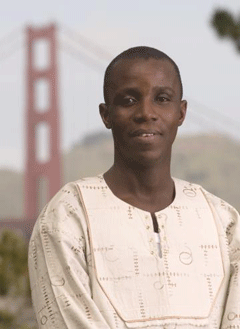
Silas Siakor, winner of the 2006 Goldman Environmental Prize (Courtesy of the Goldman Environmental Prize)
CURWOOD: Did anyone ever threaten you?
SIAKOR: Worst of all, the president at the time, Charles Taylor, he was at the head of all those illegal militia forces, different paramilitary groups, commander-in-chief of the armed forces. He was very unhappy with the report that we had published. And he went on national radio and said that if he was fortunate to ever lay hands on the person that published that report, their family would have a long time grieving. So that was a very strong remark coming from the president at the time. And I was supposed to appear before the senate to give reasons behind the publication of the report that we had published. And failure to appear would lead the senate to know to take very strong action against me.
CURWOOD: What is in your report that so angered Charles Taylor?
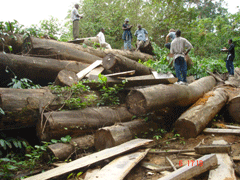
Silas Siakor and team of trainees conduct field exercise in documenting illegal logs. (Photo courtesy of Silas Siakor)
CURWOOD: So, what are you going to do next in Liberia?
SIAKOR: What we are working on now is trying to find way to strengthen local people, local communities to find their own voices. I’m not very old, but in the next five to ten years I would like to see myself do something else. So, what we are trying to do now is spend the next couple of years, five, six, seven years from now helping those communities, strengthening local structures, different grassroots institutions that would then begin to take on their own issues, take on their own cause, and stand up for their own rights. So that we don’t necessarily have to do this for them for eternity.
CURWOOD: Silas Siakor is the 2006 African winner of the Goldman Environmental Prize. Thank you so much.
SIAKOR: Thank you very much. It’s been a pleasure.
Related link:
The Goldman Environmental Prize
[MUSIC: Bob Moses “Time Stood Still (Africa and Back in a Day)” from ‘Time Stood Still’ (Gramavision - 1994)]
CURWOOD: Just ahead: the places where men go to get away from it all. First, this Note on Emerging Science from Bobby Bascomb.
[SCIENCE NOTE THEME]
Emerging Science Note/Seasonal Maladies
BASCOMB: New research published in the British Journal of Psychiatry has found that people – especially women – born in springtime have higher rates of suicide than those born at other times of the year.
A study of almost 27,000 suicides in England and Wales found that females born in April, May, or June were 30 percent more likely to commit suicide, and males 14 percent more likely, than people born in the fall. Researchers also found that mental illnesses such as depression, mood disorders – even alcohol dependence – are more common among people born in the spring.
Seasonal birth trends have been linked to several diseases including cancer, heart disease, and brain tumors. Other research indicates that people born in December are more likely to suffer from schizophrenia, Alzheimer’s, and narcolepsy.
Explanations for the observed correlation between suicide and a spring birth are preliminary. But scientists think that changes in maternal health, including infections and temperature fluctuations, may cause slight changes in brain development of the fetus, which are demonstrated later in life as depression and suicidal tendencies.
Scientists caution that suicide is a result of a complex set of biological and social factors and their research simply addresses the possible biological explanations for suicide. That’s this week’s Note on Emerging Science. I’m Bobby Bascomb.
CURWOOD: And you’re listening to Living on Earth.
Related link:
The British Journal of Psychiatry
ANNOUNCER: Support for NPR comes from NPR stations, and: Kashi, whose “Day of Change” tour features yoga, lessons, natural food cooking demos, and Kashi cereals, crackers and granola bars. Details at Kashi dot com; The Kresge Foundation, investing in nonprofits to help them catalyze growth, connect to stakeholders, and challenge greater support. On the web at Kresge dot org; The Annenberg Fund for excellence in communications and education; The W-K Kellogg Foundation. 'From Vision to Innovative Impact: 75 Years of Philanthropy' This is NPR -- National Public Radio.
[MUSIC: Axiom Funk (Bill Laswell) “Telling Time” from ‘Funkcronomicon’ (Axiom/PGD - 1995)]
The Man Cave

Duck Blind, North Carolina (Ken Ross)
CURWOOD: It’s Living on Earth. I’m Steve Curwood.
Okay. What do the hunting camp, the barbershop, the recliner and the remote control all have in common? Well, according to author Jim Twitchell, they’re all artifacts of a disappearing space – the places where men go to hide.
Professor Twitchell, who teaches advertising at the University of Florida, has been exploring the idea of what he calls “man caves” - the last places where men can go and be, well, men. He joins me now to talk about his new book, “Where Men Hide,” which features photographs of favorite male haunts.
Jim, hello!
TWITCHELL: Hi, how are you?

Duck Blind, North Carolina (Ken Ross)
TWITCHELL: When I looked at Ken’s photographs for the first time, I thought to myself, ‘boy these are the grimiest places.’ I think to some degree the places men go are the places women don’t feel comfortable. And so he feels ‘okay, this is a place I’m protected. ‘
CURWOOD: Guys hide?
TWITCHELL: I think guys hide at least in a different way from women. Women seem to be happy to separate. To go off with other women or with children. But men seem much more circumspect. It’s much more an event when men get together to do whatever it is that they’re going to do together. Whether it’s make war, or play sports, or just separate.
CURWOOD: Where would they go?
TWITCHELL: Well, in the first part of the twentieth century--I was amazed by this statistic--that the average middle class working man would spend up to four hours a week in the company of other men at his lodge. Whether he was a mason, or a moose, or an elk, or an eagle. He worked all day with other men and then when he had a chance in his free time, he went right back to that group except now not to work but to fraternize.
CURWOOD: And so those fraternal organizations went away and what, were replaced by college fraternities?
TWITCHELL: Well, certainly they went to college fraternities. But even college fraternities really are nowhere near as vibrant today as they were even a generation ago. In fact, really, many of these places that men used to go now have evaporated.
CURWOOD: Okay, so where can us guys go to get away?
TWITCHELL: Well, one of the places we go is into the car. Especially at the beginning of the SUV, almost invariably the ads had blackened windows, a guy getting in, maybe with one other guy. And they’re just taking off. In fact, my favorite was, I think, for an Isuzu where the guy actually hears the disembodied voice of God saying ‘go farther, go farther (laughs).’ He goes into the woods, deeper and deeper. And then finally in the last scene we see him on a raft heading for a waterfall and the disembodied voice says, ‘oh too far.’
CURWOOD: Now, you even explore the crawl space where Saddam Hussein was found. You seem rather nostalgic in your ride through of this.
TWITCHELL: (laughs) You know, it’s terrible but I think Saddam had it pretty close to the ideal. He goes down into this little hiding hole and he waits for the storm to pass. And then he had his upstairs house, too, where it was a terrible mess, but you could see that he had been cooking stuff. He had a copy of Dostoevsky, he had a book on the interpretation of dreams. So, he had his upstairs life. And then when the Earth starts to rumble and the bombs start to fall, up goes the little trap door and down he goes like a mole.
Interesting because men hide when they have a chance to downstairs. All these opium dens and all these gambling caves, and speakeasies, we always imagine you walk downstairs below the ground to get to them. I think that’s kind of the male place to go to pull the curtains.
CURWOOD: Yeah Jim, I gotta ask you about this. You put in your book a picture of your own little office, tucked away at your summer camp. I gotta say this really looks like the picture of adolescent rebellion. I don’t know how old you are. But I’m looking at, let’s see, an ad for cigarettes, there’s way too much junk on the desk to really get anything done. The bedding that you have in there looks like it would not be terribly comfortable. And it just really has a ratty tattered look to the thing.
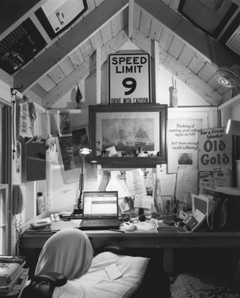
Jim’s Hidey-Hole (Ken Ross)
CURWOOD: In your book, in fact, you donate a little prose as well as the picture to this and I’d like you to read from the point where you say that men particularly like your office.
TWITCHELL: Okay.
I know that this space is special to men. Not only do I entertain the occasional passersby who tell me how nifty it is. But whenever I go to the big box stores like Lowes or Home Depot I note those little pre-fab sheds in front getting smaller and smaller, like Russian dolls. These sheds are supposed to be for tools, but I suspect that they are also so the man of the house can find a house he really can be man of. The small ones are rectangular. The large ones look like quanson huts. They often come with a door and little windows. Just like a child’s play house. Sometimes they are done in the style of a log cabin. In ads they are invariably populated by men.
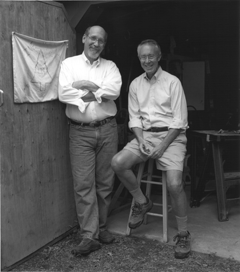
Author James Twitchell and Photographer Ken Ross (Donald Standing)
TWITCHELL: (laughs) Well, you go and take a look. But my suspicions are it’s space the guy is looking at because he knows that it will be his space. All other space in the house and even in the garage is up for grabs. It used to be that a man had a cellar, that’s where his tools were. Or he had a garage that’s where his car and engine was. But now we’ve lost the cellar, and very often the garage. Well, he can’t work on the car, the car is much too complicated. So, maybe these little sheds out in the corner of his life is where he goes for respite.
CURWOOD: Jim Twitchell is professor of English and advertising at the University of Florida. His new book is “Where Men Hide.” Jim, thanks for coming out of hiding.
TWITCHELL: It was my pleasure.
Related link:
"Where Men Hide" by James Twitchell
The Eco-Lap of Luxury

A Happy Planet room features organic bedding, along with furniture and floors made from rescued timber. (Dan Stone/Netstrom.com)
CURWOOD: If you guys want to come out of your caves and socialize with the rest of humanity, we found one place where you can still get away from it all – but do it in style, grace and go green, too.
On a recent stop in San Francisco someone told us about the Hotel Triton, a funky, eclectic place to stay on the edge of Chinatown that claims to be one of the top environmentally-friendly hotels in the city – complete with eco-friendly rooms and eco-celebrity suites. So we stopped by to check it out.

A Happy Planet room features organic bedding, along with furniture and floors made from rescued timber. (Dan Stone/Netstrom.com)
[MUSIC: Otto Sieben “Curley Shirley” from ‘Music For TV Dinners’ (Scamp – 1997)
PACE: Hi Steve, welcome to the Hotel Triton, I’m Michael. Nice to meet you.
CURWOOD: My pleasure.
PACE: My name is Michael Pace, I’m the director of environmental programs for Kimpton Hotels.
CURWOOD: This is an eco-hotel.
PACE: This is an eco-hotel. We’re at the hotel Triton in San Francisco. It’s Kimpton Hotel’s most eco-friendly hotel in San Francisco.
CURWOOD: So far, a whale hasn’t hugged me. What’s so eco-friendly about this?
PACE: (laughs) That’s the beauty of it. I’ll show you as we go up to the rooms all the beautiful things that we’re doing for the environment.
[MUSIC UP AND UNDER]
PACE: The hotel was designed by a group of local designers and artists in the early nineties. It was the first time that we as a company decided to let go from the control of the design aspect and we said to the designers and artists, ok go create a fun hotel, make it different, make it something unique for the guests. Something that San Francisco hasn’t seen before.
Shall we go upstairs? I can show you some of our eco-rooms and some celebrity suites which are a lot of fun here at the hotel.
[MUSIC: Herbert von Karajan “The Blue Danube” from ‘2001: A Space Odyssey (Soundtrack)’ (Rhino/WEA –1996)]
PACE: So, Steve, I’m taking you up in our mood elevator. As you can see the lighting is very different than a regular hotel.
CURWOOD: It’s very low.
PACE: Yes, it is. And the other one is a little bit brighter and a lavender color. It’s supposed to help you relax or get ready for the evening depending if you’re coming up or going down.
[MUSIC: Herbert von Karajan “The Blue Danube” from ‘2001: A Space Odyssey (Soundtrack)’ (Rhino/WEA –1996)
[DOOR OPENS]
PACE: Okay, so welcome to the original eco-floor at the Hotel Triton. And this is really where it all began. In 1995 as we were developing the concept of the hotel, we came up with the concept of having a whole floor dedicated to environmentally aware policies and procedures, and programs for the guests. We’re going to go into a couple of rooms, and I’m going to show you exactly what we did to retrofit or outfit the rooms to be more eco-friendly.
[MUSIC: Herbert Stothart “Optimistic Voices” from ‘The Wizard of Oz (Soundtrack)’ (Rhino/WEA – 1995)]
SINGING: Open, Open
[UNLOCKING DOOR]
PACE: Follow me right through. We’re in room 712. We’re on the top floor of the hotel. And one of the things you may notice is that it doesn’t look particularly eco. Or obviously eco to anybody. So what we have done is we’ve really focused on being non-intrusive in the way we run our hotel’s eco programs.
We want guests to come and stay in the hotels because they enjoy the environment of the room and know that they are helping the environment, but not in a jarringly negative way or screaming in your face ‘eco-friendly.’
[MUSIC: Tony Bennett “This Can’t Be Love” from Sings For Lovers” (Concord Jazz – 2006)
PACE: So, some of the things that we have in the eco-friendly rooms, are starting with the bathrooms. The water filtration unit with the flow controls. So we’re also purifying the water as well as reducing the amount of water being used in the bathroom. The shower pressure is still as good as it would be without, but it’s more pure water and it’s only coming down at 2.5 gallons per minute. We are eliminating, basically, all packaging of small bottles of soaps and shampoos. And that’s a big part of the waste reduction program in the hotel. By using these amenity dispensers we cut down 100 percent on that. The soap, the shampoo, and even the hand lotion, is also eco-friendly. It’s biodegradable, it’s non-toxic, and it’s hypoallergenic.
Above the armoire you may notice a filtration unit. That has a special filter in it—a HEPA filter-- that attracts all the pollen and the fine dust particles in the room. So it’s continuously working 24 hours a day. We have energy efficient lighting in the rooms. And a big part of what we do in these rooms also is that we clean them with environmentally friendly cleaners--non-chemical cleaning products.
The sheets on the beds are actually made out of organic linens. And the towels in the bathrooms are made out of organic linen also.
[MUSIC: Tony Bennett “This Can’t Be Love” from Sings For Lovers” (Concord Jazz – 2006)]

The Woody Harrelson Suite (The Hotel Triton)
[MUSIC: G. Portnoy & J. Hart Angelo “Where Everybody Knows Your Name (‘Cheers’ Theme)” from ‘Televisions Greatest Hits, Volume 3: 70’s & 80’s’ (TVT – 1990)]
PACE: Okay, so we’re at Woody’s Oasis. And it’s named after him and his foundation- the non-profit Oasis Foundation. And even the base you can see is clad in bamboo. So, when we developed the concept of embracing the eco-room concept and converting the hotel into being completely eco-friendly we asked Woody if he’d like to join us in the effort and help us design a suite.
[MUSIC UP AND UNDER]
PACE: The flooring is bamboo flooring. This was our first attempt at actually putting bamboo or hardwood flooring in a guest room. It’s very durable and it’s also at the same time rather soft to the feel so it’s got a very comfortable feel to it.
[MUSIC: Martin Denny “Love Dance” from ‘The Exciting Sounds of Martin Denny: Exotica, Volumes 1 & 2’ (Scamp – 1996)]
PACE: The paint that we used to paint the walls is actually what they call a low VOC paint. A low volatile organic compound paint, which means that it has no chemicals or hardly any chemicals in it compared to regular paint.
The soft fabrics that you see, the drapes on the windows, the headboard, the duvet covers, and the pillow covers are all made out of hemp. So that was another effort for us to go towards using organic and natural products.
We do recycle in our hotels. And that is a big part of what we’re doing in our environmental program. At the Triton, this was the first hotel where we actually asked the guests to recycle with us. This is why it’s fun to have an eco program that is a continuous evolution of standards and implementation. So the beauty for us is to set up a system and a culture of environmental awareness that thrives and keeps growing on ideas and suggestions and interactions with the community, with the employees, with the guests.
[ELEVATOR SOUND]
PACE: Well, here we are. Back at the lobby again.
CURWOOD: Well, I want to thank you for taking this time with me today.
PACE: Well, thank you, Steve. It’s been a pleasure.
CURWOOD: Our audio tour of the Hotel Triton in San Francisco was produced by Dennis Foley.
Related link:
The Hotel Triton
[MUSIC: (End Piece Music) Sonny Rollins “Saint Thomas” from ‘Saxophone Colossus’ (OJC – 1991)]
What Calls Beneath
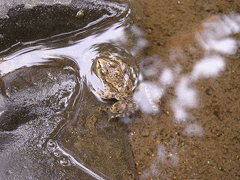
The Columbia spotted frog (Erik Hendrickson)
CURWOOD: Some sounds are secret. A child whispers in another child's ear. A spy taps out a secret code. And nature is no different. As part of the Western Soundscape Project, Jeff Rice reports on one frog’s hidden messages.
RICE: The thing about frogs is this: you rarely see them. But they're loud when they want to be, and that's usually right around this time of year.
[CHORUS FROG SOUNDS]
RICE: I recorded these chorus frogs in northern Utah at a big marsh near the Great Salt Lake. This is their spring mating ritual, and they gather together in an amorous frenzy of loud choruses.

The Columbia spotted frog (Erik Hendrickson)
RICE: Nothing unusual here. Typical frog behavior.
But a little further up on the hillside, in the smaller streams and marshes, what is interesting is what you don't hear.
[FADE CHORUS FROGS]
RICE: There are these other frogs, Columbia Spotted Frogs, that don't do things in the conventional way. To hear them, you would have to stick your head – or a microphone – under the water.
[UNDERWATER FROG SOUND]
PLATZ: Most of the frogs I've been working with call several feet down and you don't hear anything in the air.
RICE: Dr. James Platz is a biologist at Creighton University in Omaha, and he travels around studying these underwater calls. He first discovered this behavior in frogs in 1989.
PLATZ: I was working in a narrow canyon and I spent most of the evening at a pond. There were no animals calling whatsoever. I must have been there until three or four a.m. in the morning. It was a soundless night. So I came back about 7 or 8 the next morning, and when we got there there were three egg masses.
RICE: Obviously the frogs had found each other to mate. The egg masses were proof of that. But what struck Platz as odd is that most frogs would have been calling out loud.
[UNDERWATER FROG SOUNDS]
PLATZ: And the following spring we took a hydrophone down and discovered to our pleasant surprise that they were quite noisy. They just called underwater.
RICE: Platz says the advantages could be many. By calling underwater, the frogs don't alert predators. They can also start the breeding season earlier because the water is typically warmer than the air.
On the other hand, without much of an above-ground call, these frogs can tend to get overlooked by humans. Destruction of their wetland habitats has led to severe declines in their numbers across several western states. Columbia Spotted Frog populations in southern Idaho and parts of Utah and Nevada are candidates for listing under the federal Endangered Species Act.
[UNDERWATER FROG CALLS]
RICE: For Living on Earth, I'm Jeff Rice.
Related link:
James Platz, Biology Professor
[FROG CALLS]
CURWOOD: We leave you this week – the sound of a frog that keeps its head well above water.
[BARKING FROG CALLS]
CURWOOD: Carlos Davidson recorded these Mountain Treefrogs barking away in Coconino National Forest in Arizona.
[EARTH EAR: “Mountain Tree Frog” recorded by Carlos Davidson from ‘Frog and Toad Calls of the Rocky Mountains: Vanishing Voices’ (Library of Natural Sounds – 1996)]
CURWOOD: Living on Earth is produced by the World Media Foundation. Our crew includes Ashley Ahearn, Chris Ballman, Eileen Bolinsky, Jennifer Chu, Bruce Gellerman, Ingrid Lobet and Jeff Young - with help from Christopher Bolick, Kelley Cronin, and James Curwood. Our interns are Bobby Bascomb and Emily Taylor. Our technical director is Dennis Foley. Alison Dean composed our themes. You can find us at LOE dot org. I’m Steve Curwood. Thanks for listening.
ANNOUNCER: Funding for Living on Earth comes from the National Science Foundation, supporting coverage of emerging science; Kashi, whose “Day of Change” tour features yoga, lessons, natural food cooking demos, and an array of Kashi products. Details at Kashi dot com. Stonyfield Farm. Organic yogurt, smoothies, and milk. Ten percent of profits are donated to efforts that help protect and restore the earth. Details at Stonyfield dot com. Support also comes from NPR member stations, the Ford Foundation, the Oak Foundation, and the Saunders Hotel Group of Boston's Lennox and Copley Square Hotels. Serving you and the environment while helping preserve the past and protect the future, 800-225-7676.
ANNOUNCER2: This is NPR, National Public Radio.
Living on Earth wants to hear from you!
Living on Earth
62 Calef Highway, Suite 212
Lee, NH 03861
Telephone: 617-287-4121
E-mail: comments@loe.org
Newsletter [Click here]
Donate to Living on Earth!
Living on Earth is an independent media program and relies entirely on contributions from listeners and institutions supporting public service. Please donate now to preserve an independent environmental voice.
NewsletterLiving on Earth offers a weekly delivery of the show's rundown to your mailbox. Sign up for our newsletter today!
 Sailors For The Sea: Be the change you want to sea.
Sailors For The Sea: Be the change you want to sea.
 The Grantham Foundation for the Protection of the Environment: Committed to protecting and improving the health of the global environment.
The Grantham Foundation for the Protection of the Environment: Committed to protecting and improving the health of the global environment.
 Contribute to Living on Earth and receive, as our gift to you, an archival print of one of Mark Seth Lender's extraordinary wildlife photographs. Follow the link to see Mark's current collection of photographs.
Contribute to Living on Earth and receive, as our gift to you, an archival print of one of Mark Seth Lender's extraordinary wildlife photographs. Follow the link to see Mark's current collection of photographs.
 Buy a signed copy of Mark Seth Lender's book Smeagull the Seagull & support Living on Earth
Buy a signed copy of Mark Seth Lender's book Smeagull the Seagull & support Living on Earth

